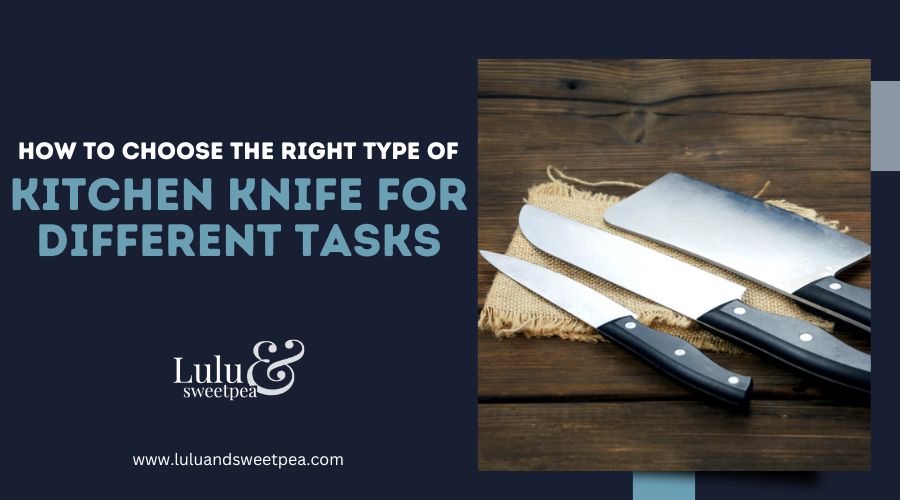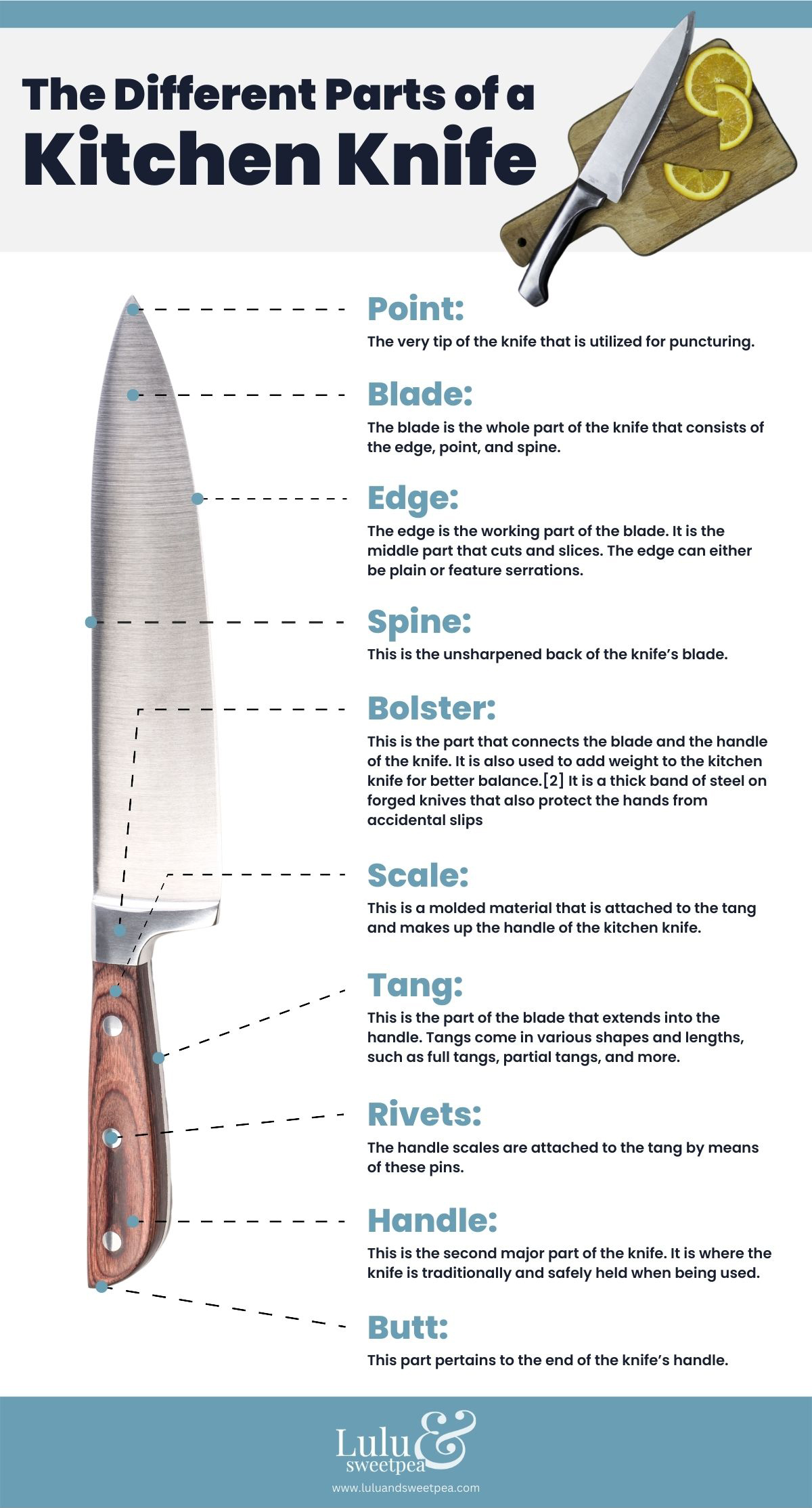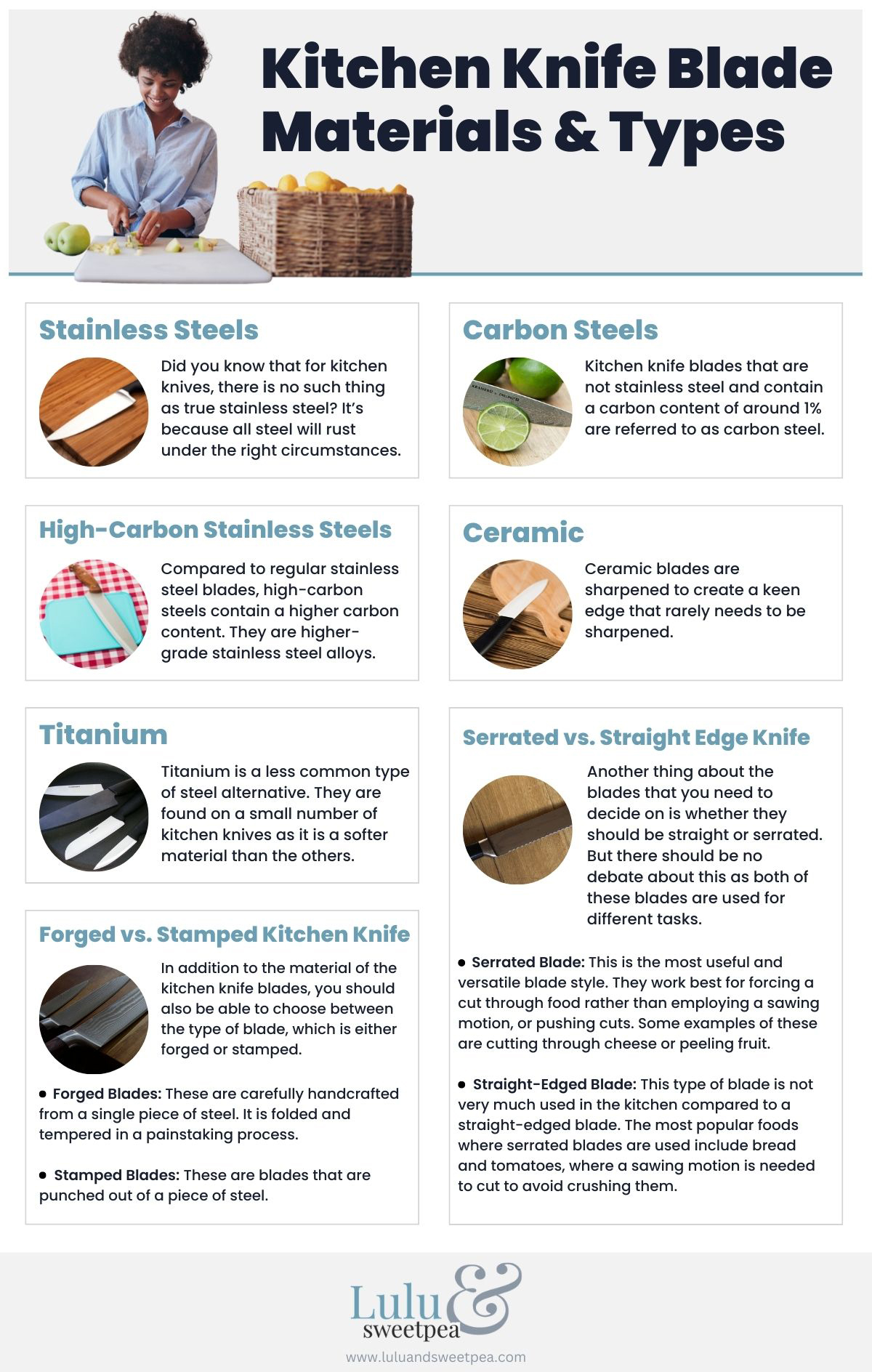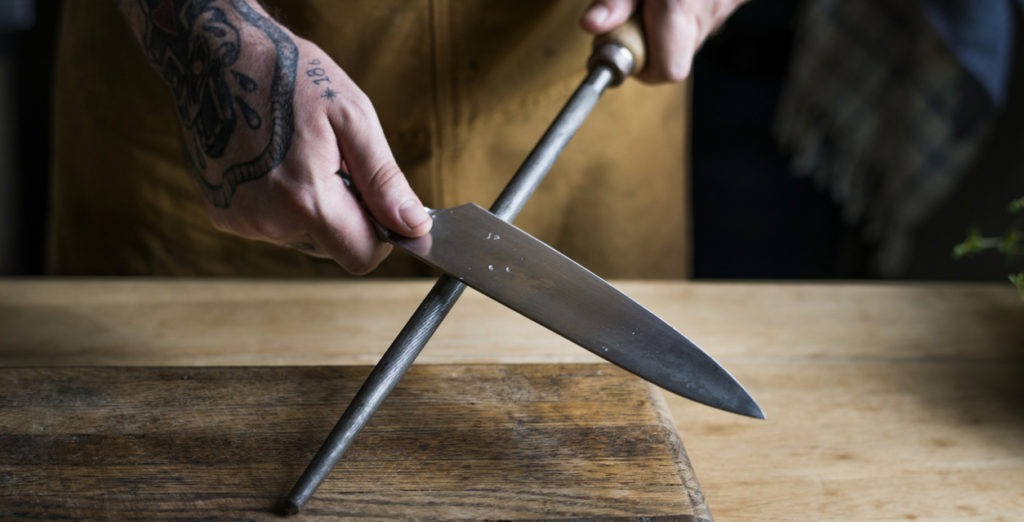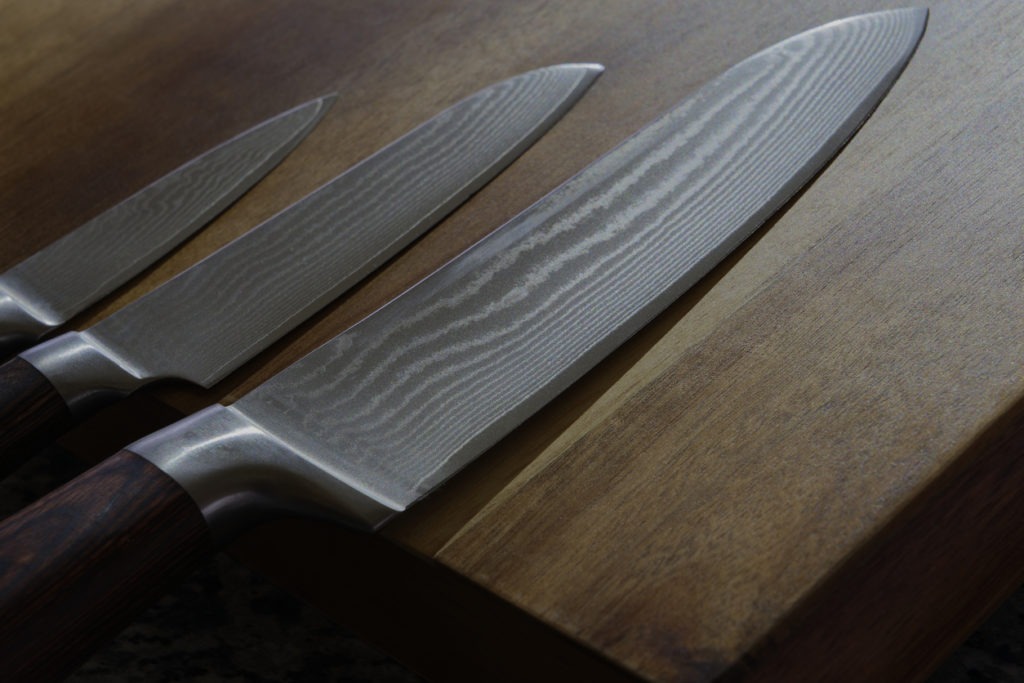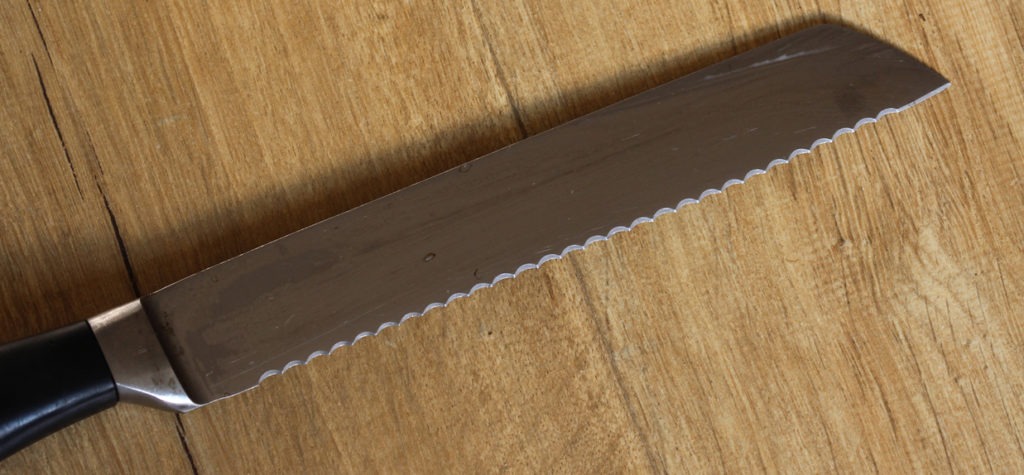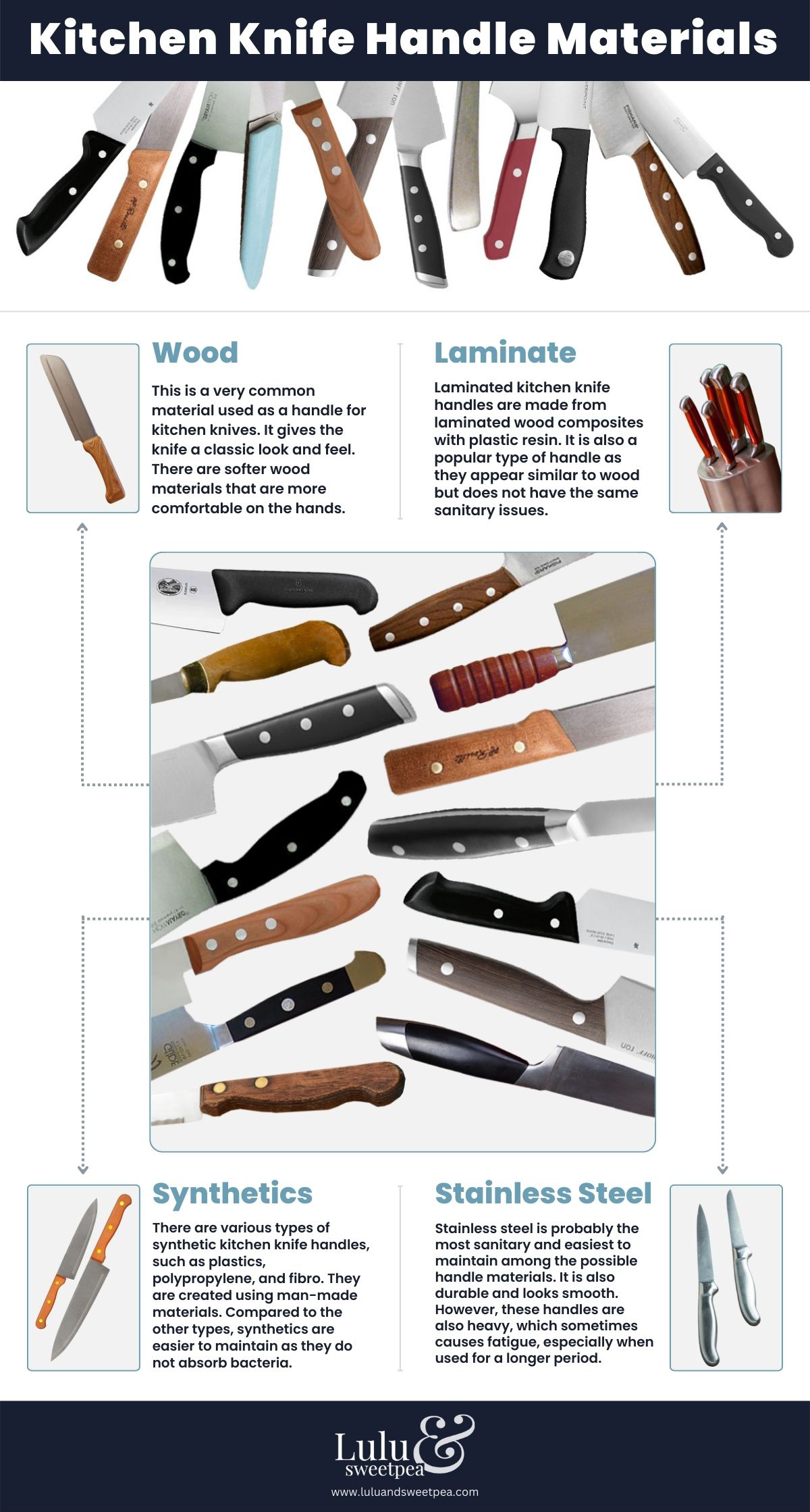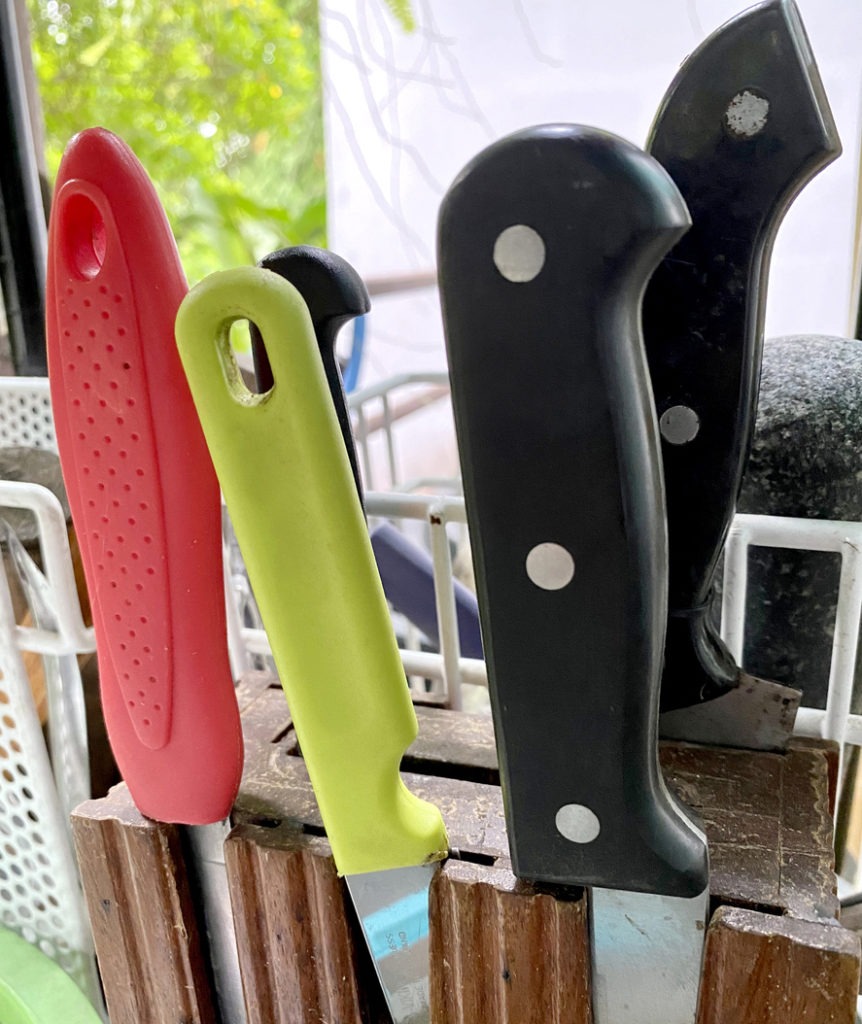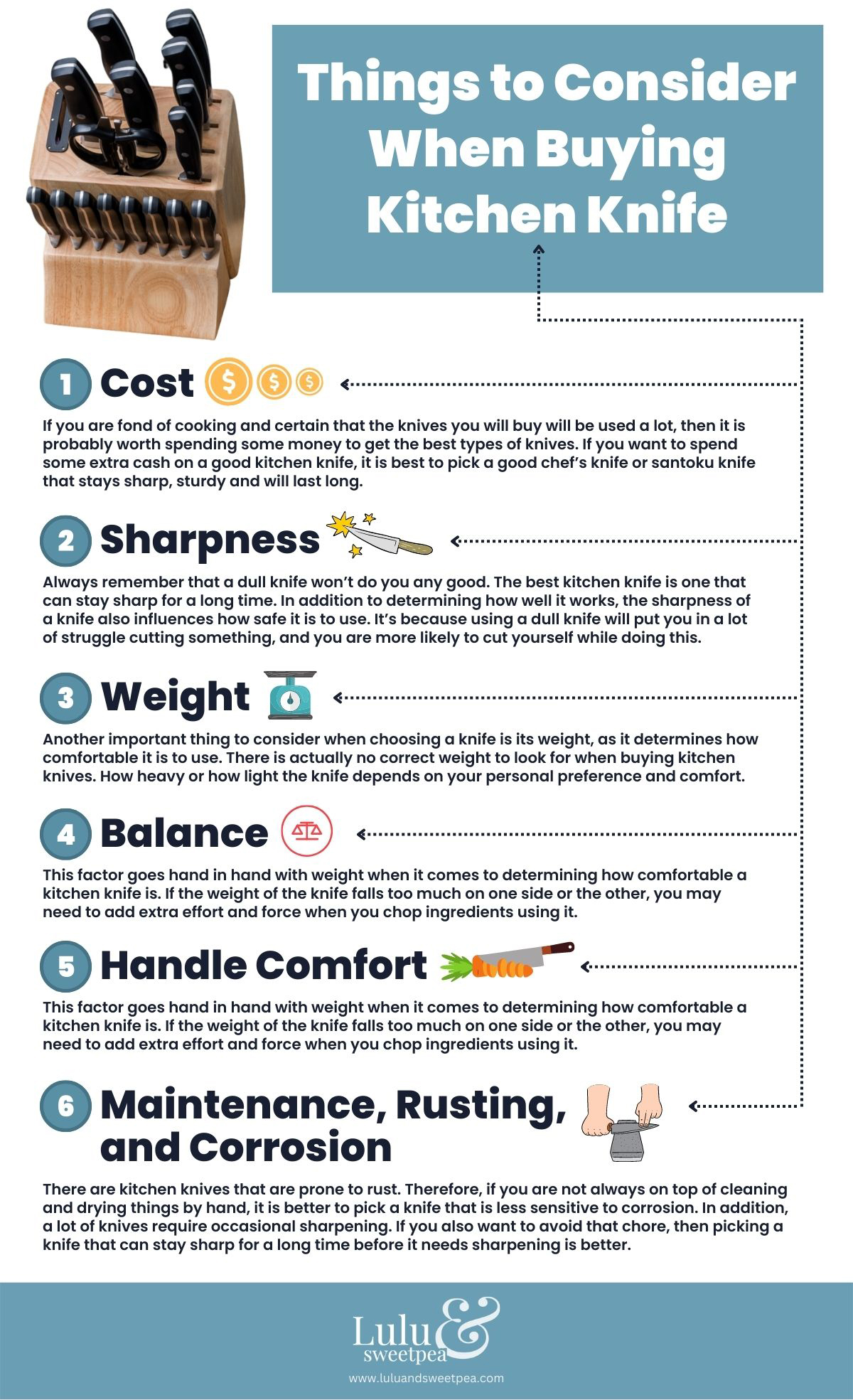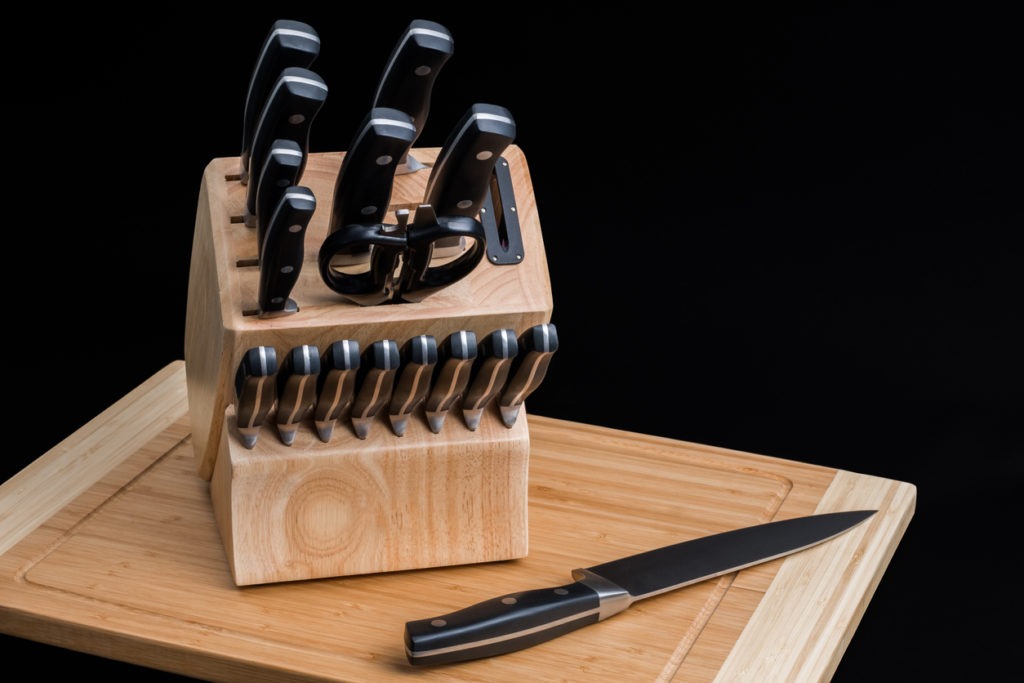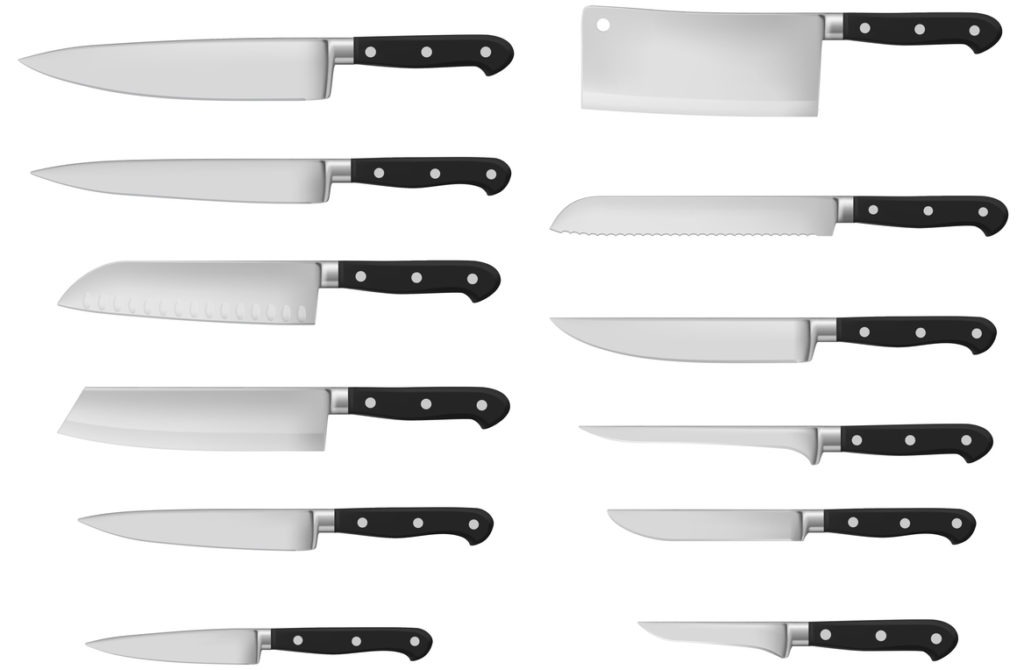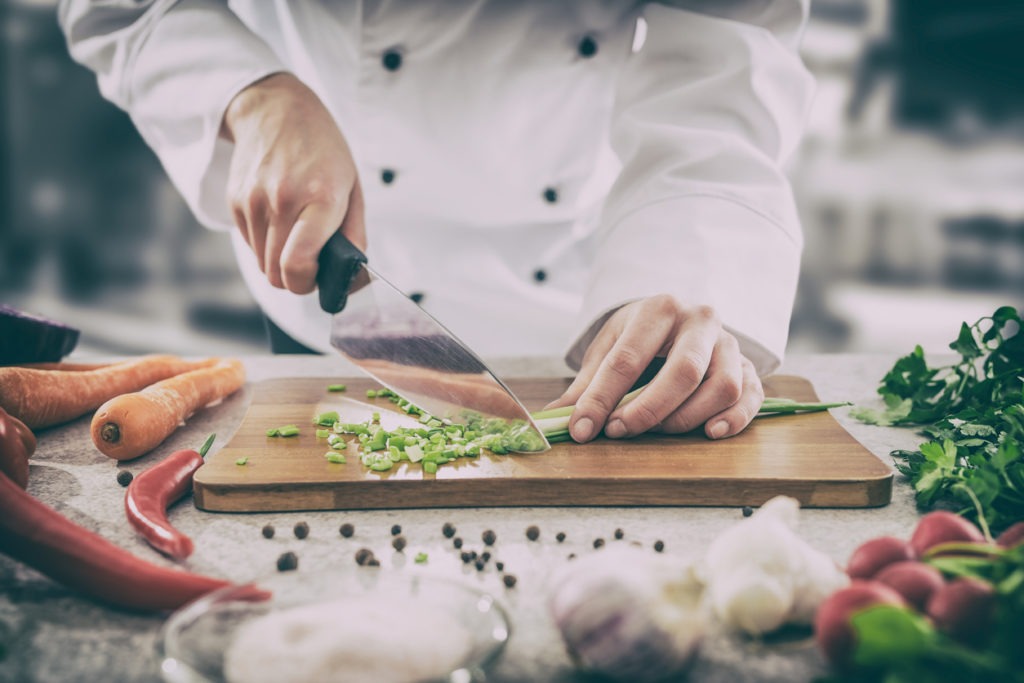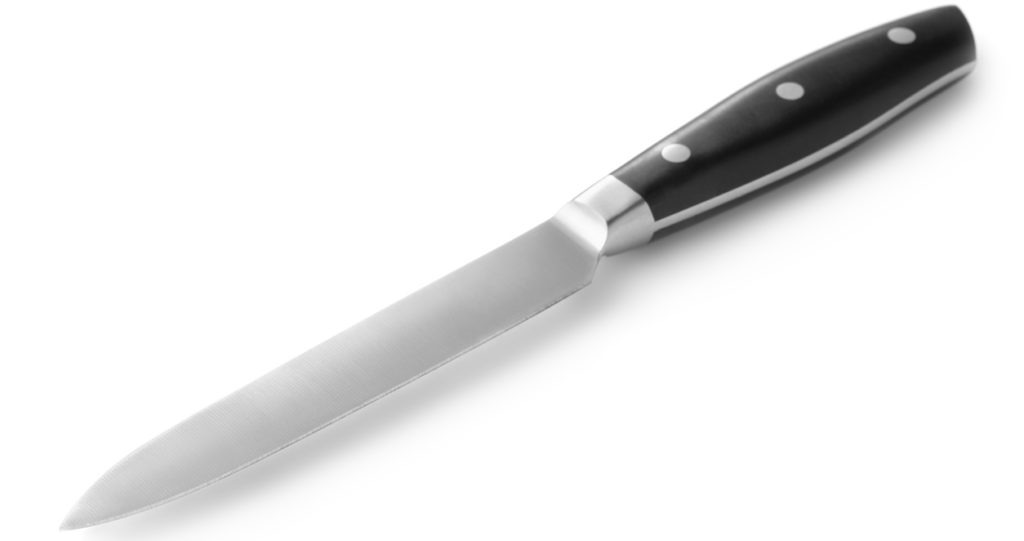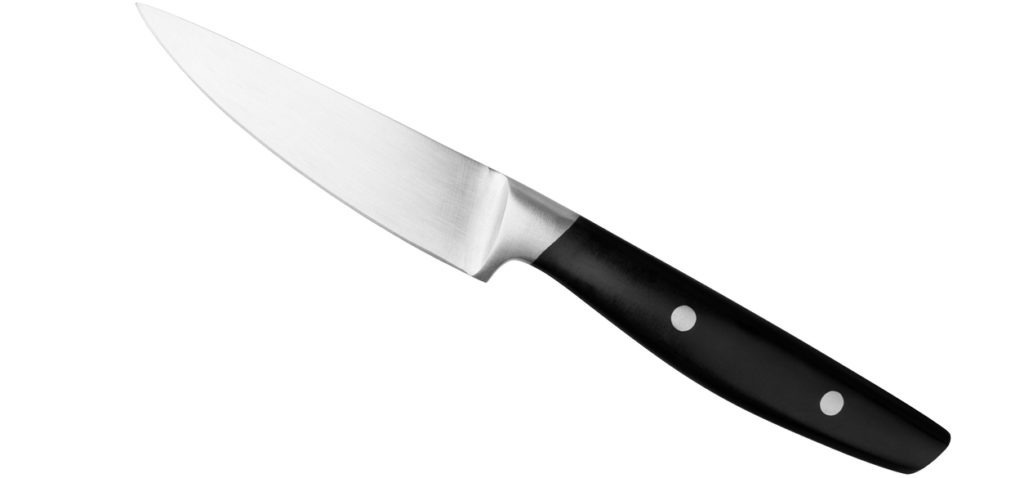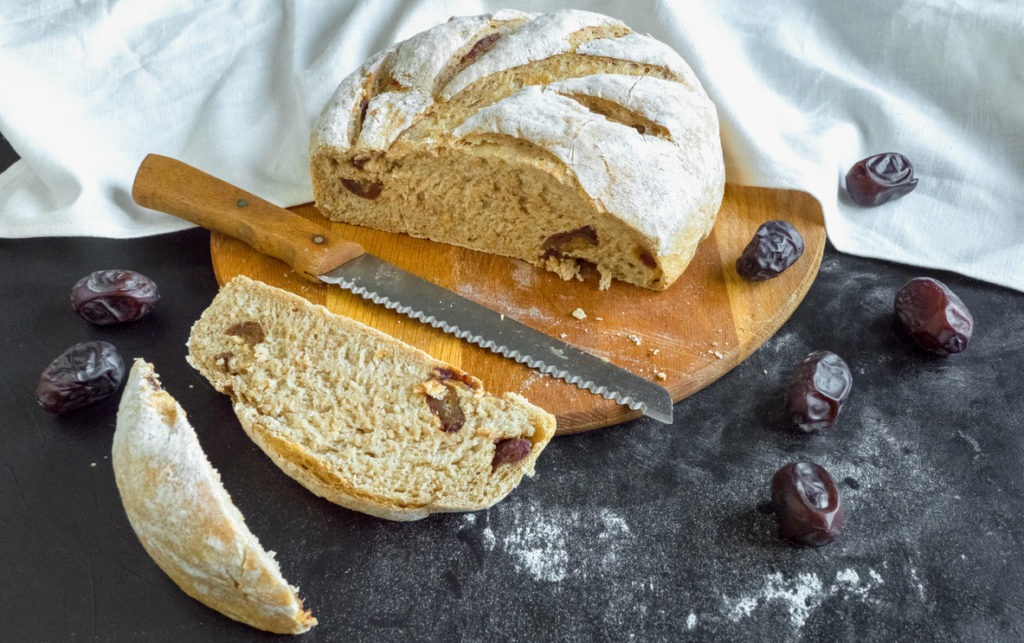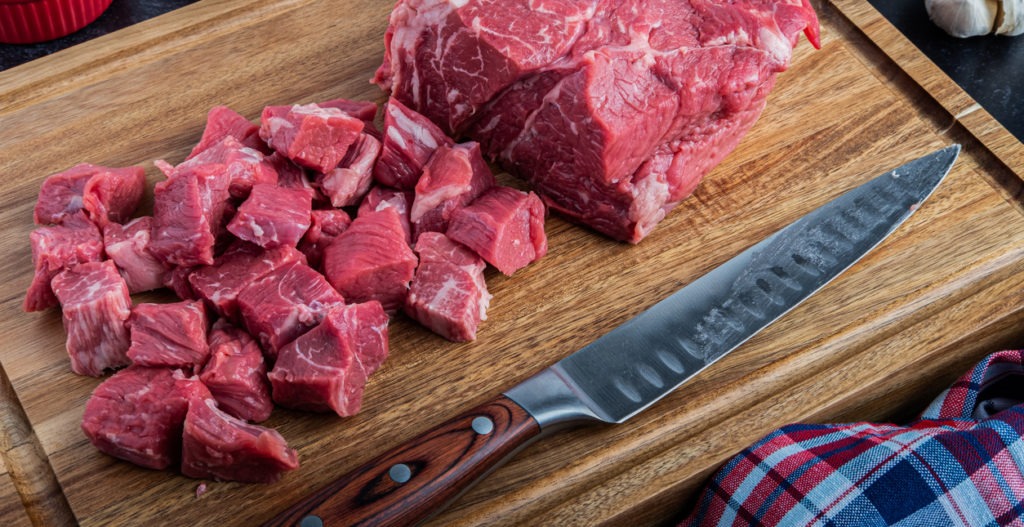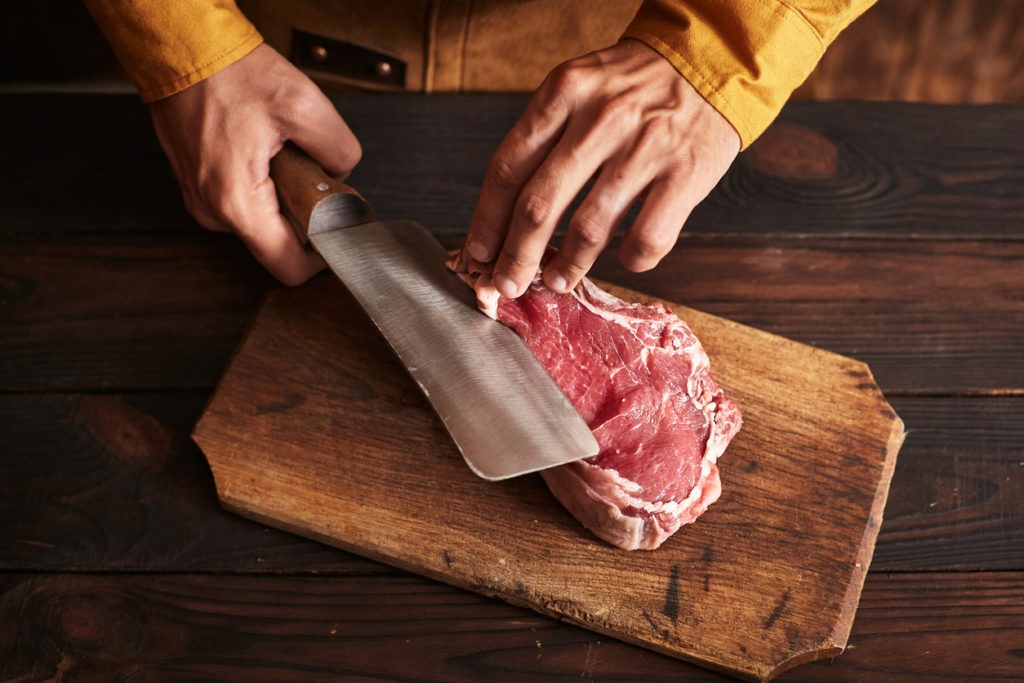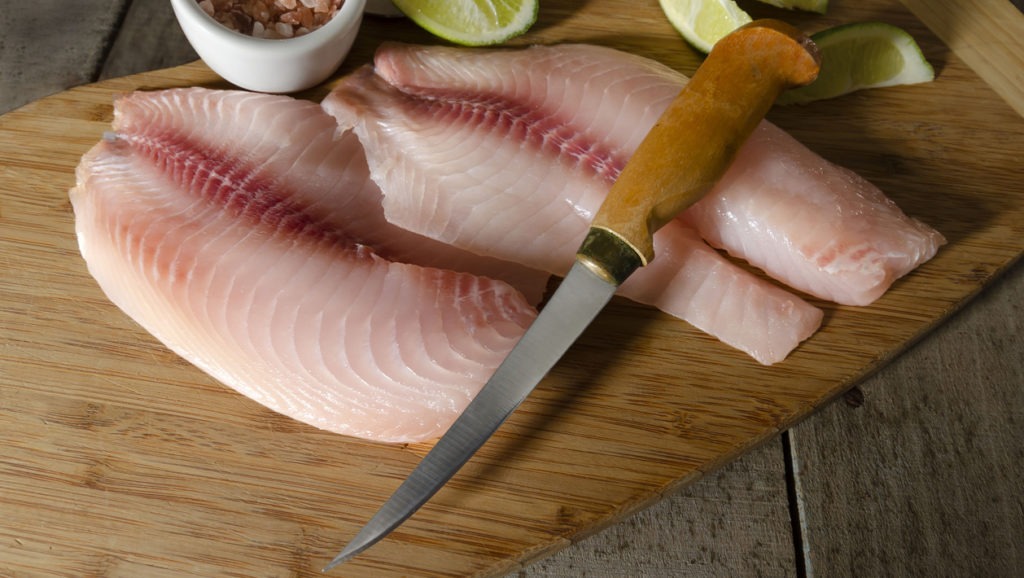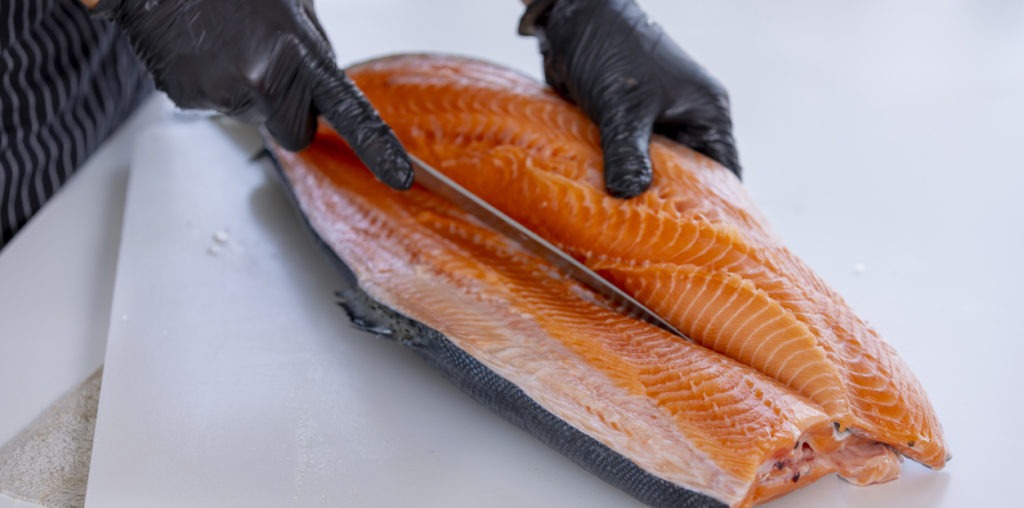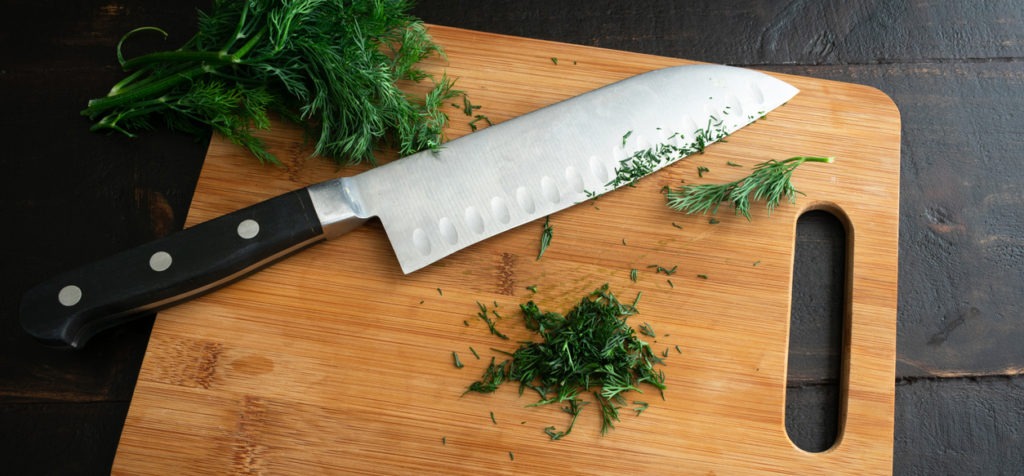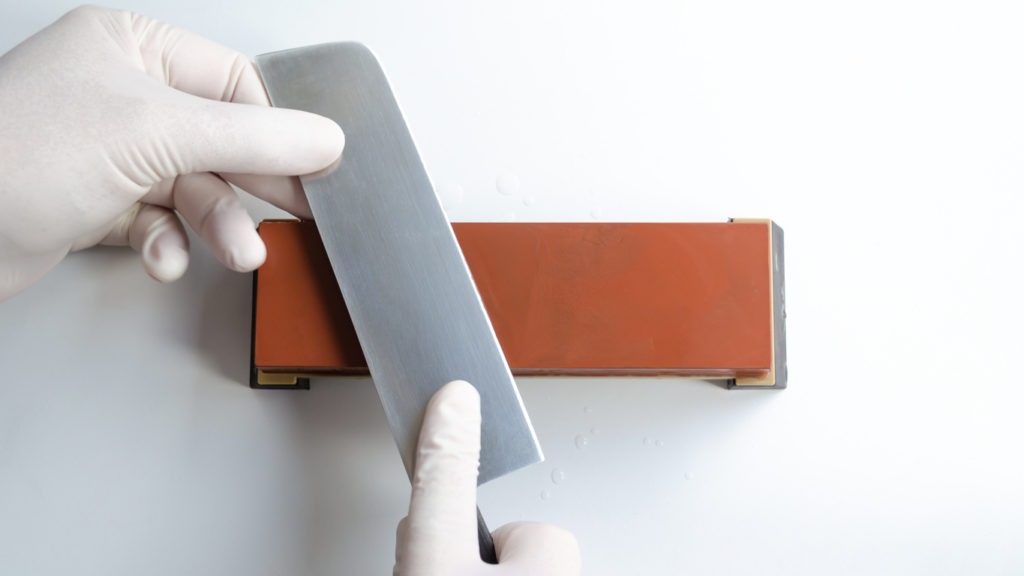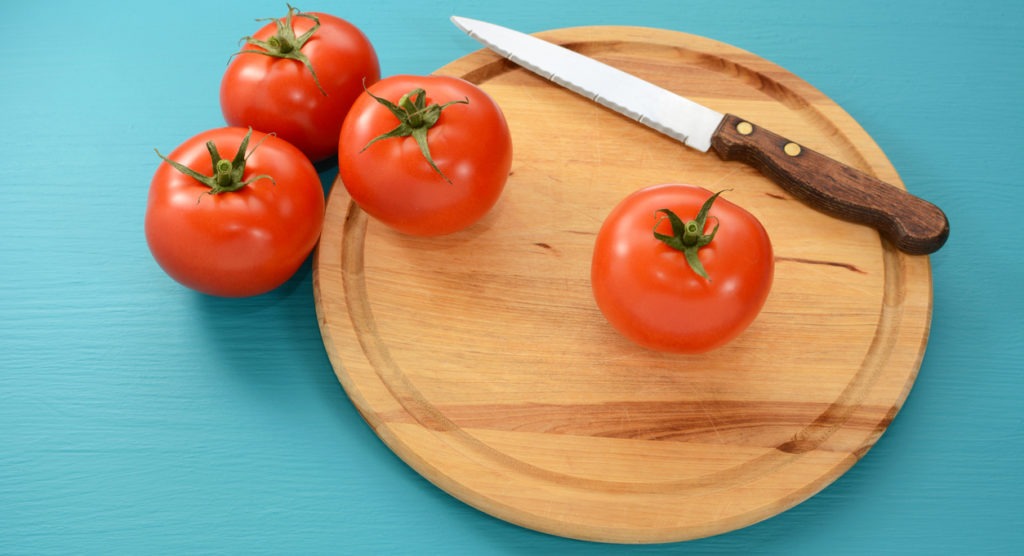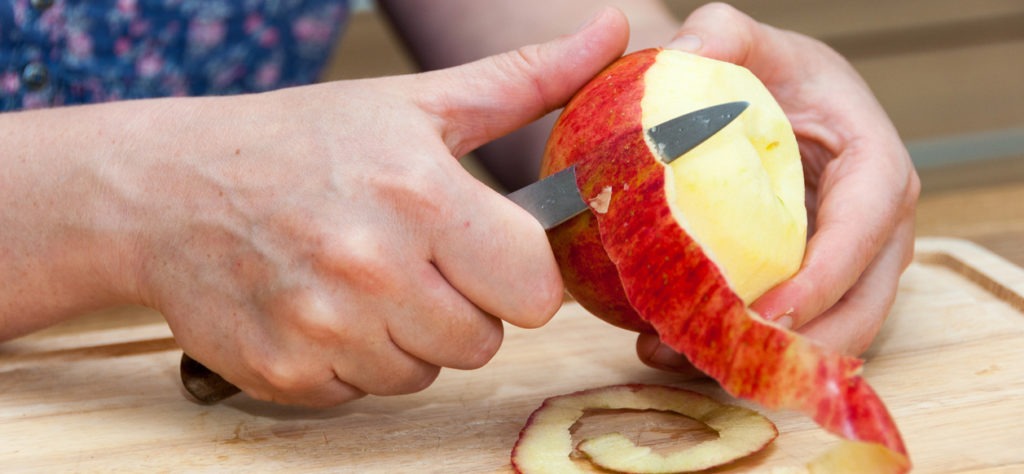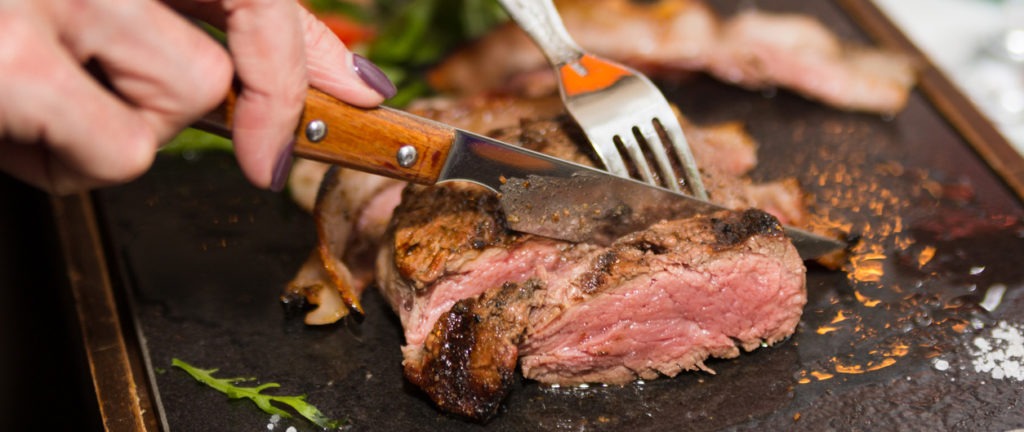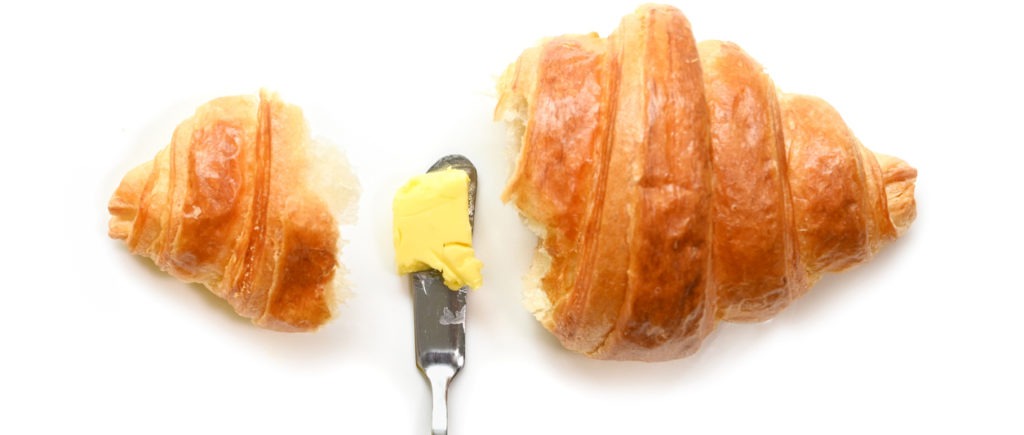One of the most important tools that are needed in the kitchen to be able to prepare ingredients for cooking and food preparation is the kitchen knife. Owning a sharp kitchen knife is very essential as it is the only tool that can do everything, from cutting up a whole chicken to mincing herbs finely. [1] It may seem easy to buy a kitchen knife as it is always available in stores and even online. However, it can also become challenging with the variety of knives being offered today.
Do you have any idea what a boning knife and a paring knife are? Do you know the right type of knife that you need to cut a side of beef effectively? Why do you think there are ceramic blades and stainless steel blades? Before you go out or order a kitchen knife online, it is better to learn more about this helpful tool first.
Kitchen knives are always used for chopping vegetables, slicing up cheese, carving a turkey, and more, making them essential tools in food preparation. Therefore, choosing the right knives for the job is important. However, doing that is not always easy. Since there are dozens of kitchen knives available today, matching the right one to various kitchen tasks can become confusing. But no worries, as we are here to help you. In this post, we are giving you a guide on how to choose the right type of kitchen knife for different tasks.
The Different Parts of a Kitchen Knife
Before we talk about the various types of kitchen knives to choose from, let us first understand the basics. Learning about the common terminologies and basic anatomy of a kitchen knife is also essential to be able to pick the right one for your needs. Below are the different parts of a kitchen knife:
Blade: The blade is the whole part of the knife that consists of the edge, point, and spine. [2]
Bolster: This is the part that connects the blade and the handle of the knife. It is also used to add weight to the kitchen knife for better balance. [2] It is a thick band of steel on forged knives that also protect the hands from accidental slips. [1]
Butt: This part pertains to the end of the knife’s handle. [2]
Edge: The edge is the working part of the blade. It is the middle part that cuts and slices. [1] The edge can either be plain or feature serrations. [2]
Handle: This is the second major part of the knife. It is where the knife is traditionally and safely held when being used. [2]
Point: The very tip of the knife that is utilized for puncturing. [2]
Tang: This is the part of the blade that extends into the handle. Tangs come in various shapes and lengths, such as full tangs, partial tangs, and more. [2]
Rivets: The handle scales are attached to the tang by means of these pins. [2]
Scale: This is a molded material that is attached to the tang and makes up the handle of the kitchen knife. [2]
Spine: This is the unsharpened back of the knife’s blade. [2]
Kitchen Knife Blade Materials and Types
After learning about the different parts that make up a kitchen knife, let us move on to understanding the different blade materials available for kitchen knives. Below are some of the options that you have:
Stainless Steels
Did you know that for kitchen knives, there is no such thing as true stainless steel? It’s because all steel will rust under the right circumstances. Therefore, the right term should be stain-resistant steel. For steel to be considered stainless, it needs to have at least a specific amount of chromium. While the number varies, it is usually around 10.5% or more. This way, the blade will be resistant to decay, wear, and corrosion.
The main advantage of using kitchen knives with stainless steel blades is that it’s less likely to rust compared to a still with higher amounts of carbon. This is essential to consider as kitchen knives handle foods, and their juice will get on the knife, which increases the possibility of stains. In addition, stainless steel blades also need less maintenance. However, while they are stain-resistant, stainless steel blades mostly suffer in performance. But it depends mainly on the type of stainless steel used. [2]
Carbon Steels
Kitchen knife blades that are not stainless steel and contain a carbon content of around 1% are referred to as carbon steel. These blades do not have significant amounts of chromium, and they often include alloys like vanadium and manganese. Carbon steel blades are popular for their reasonable price and performance. They are very easy to sharpen and can have a keen edge. However, its downside is being susceptible to stains. [2]
High-Carbon Stainless Steels
Compared to regular stainless steel blades, high-carbon steels contain a higher carbon content. They are higher-grade stainless steel alloys. These blades are stronger and have increased edge retention and cutting ability, but it does not sacrifice their resistance to stains. It is a high-quality type of kitchen knife blade. However, it is also more expensive compared to stainless and carbon steel blades. [2]
Ceramic
Ceramic blades are sharpened to create a keen edge that rarely needs to be sharpened. They have thin edges that make them great for cutting fruits and vegetables. However, it is not that great to be used for meat and frozen goods.
The best thing about ceramic blades is that they can thrive in harsh environments. They will not rust even when used to slice into acidic foods. They are also lightweight but sturdy. However, compared to their steel counterparts, these blades are still more brittle. They can keep an edge for much longer than steel blades, but when it dulls, sharpening it might need professional help. [2]
Titanium
Titanium is a less common type of steel alternative. They are found on a small number of kitchen knives as it is a softer material than the others. The best thing about titanium blades is their neutral composition. This means that they do not have any chemical reactions to foods. In addition, it is more flexible compared to steel. However, the downside is that it is more expensive as it is considered a specialty material. [2]
Forged vs. Stamped Kitchen Knife Blades
In addition to the material of the kitchen knife blades, you should also be able to choose between the type of blade, which is either forged or stamped.
- Forged Blades: These are carefully handcrafted from a single piece of steel. It is folded and tempered in a painstaking process. They are sharper, more durable, and can keep an edge longer. However, forged blades take longer to make, making them more expensive. [3]
- Stamped Blades: These are blades that are punched out of a piece of steel. They are not folded, tempered, or processed. This means that they are not as high quality as forged blades. But these are much less expensive. [3]
Serrated vs. Straight Edge Kitchen Knife Blades
Another thing about the blades that you need to decide on is whether they should be straight or serrated. But there should be no debate about this as both of these blades are used for different tasks.
- Straight-Edged Blade: This is the most useful and versatile blade style. They work best for forcing a cut through food rather than employing a sawing motion, or pushing cuts. Some examples of these are cutting through cheese or peeling fruit.
- Serrated Blade: This type of blade is not very much used in the kitchen compared to a straight-edged blade. The most popular foods where serrated blades are used include bread and tomatoes, where a sawing motion is needed to cut to avoid crushing them. [2]
Kitchen Knife Handle Materials
Now that you’ve learned about kitchen knife blades let us now talk about the handle materials of kitchen knives. It is also essential to learn about the handle materials of kitchen knives, as it will affect how comfortable it is to use the knife when preparing food. Below are the different handle materials that you can choose from when buying a kitchen knife:
Wood
This is a very common material used as a handle for kitchen knives. It gives the knife a classic look and feel. There are softer wood materials that are more comfortable on the hands. There are also lots of options to choose from, as handles are made with various types of woods, such as olive and maple. However, wooden handles are susceptible to bacteria, and it is quite difficult to sterilize. They are also not as durable compared to other materials. [2]
Laminate
Laminated kitchen knife handles are made from laminated wood composites with plastic resin. It is also a popular type of handle as they appear similar to wood but does not have the same sanitary issues. They are easier to clean and maintain. There is also not much disadvantage when it comes to laminated handles. Some just don’t like them as they are not actually wood. [2]
Synthetics
There are various types of synthetic kitchen knife handles, such as plastics, polypropylene, and fibro. They are created using man-made materials. Compared to the other types, synthetics are easier to maintain as they do not absorb bacteria. However, the downside is that when they are exposed to extreme temperatures, they may become brittle and start cracking. They are also lighter, which may cause an imbalance in the knife’s weight. [2]
Stainless Steel
Stainless steel is probably the most sanitary and easiest to maintain among the possible handle materials. It is also durable and looks smooth. However, these handles are also heavy, which sometimes causes fatigue, especially when used for a longer period. They can also become slippery when wet, but some have added ridges and bumps for better grip. [2]
Things to Consider When Buying Kitchen Knives
Aside from learning about the different blade and handle materials, there are other important factors that you need to consider in order to buy the right kitchen knife for your needs. Below are some of them:
Cost
If you are fond of cooking and certain that the knives you will buy will be used a lot, then it is probably worth spending some money to get the best types of knives. If you want to spend some extra cash on a good kitchen knife, it is best to pick a good chef’s knife or santoku knife that stays sharp, sturdy and will last long.
However, for the other types of knives, it is probably not that essential to spend a lot, particularly for those that will not get used frequently. But in some cases, spending a bit more to upgrade to a better brand means the knife lasts longer and is more comfortable and reliable to use. [4]
Sharpness
Always remember that a dull knife won’t do you any good. The best kitchen knife is one that can stay sharp for a long time. In addition to determining how well it works, the sharpness of a knife also influences how safe it is to use. It’s because using a dull knife will put you in a lot of struggle cutting something, and you are more likely to cut yourself while doing this. Therefore, make sure that you choose a sharp knife that can last for a long time. [4]
Weight
Another important thing to consider when choosing a knife is its weight, as it determines how comfortable it is to use. There is actually no correct weight to look for when buying kitchen knives. How heavy or how light the knife depends on your personal preference and comfort. For some people, lightweight knives are easier to use, while others find heavier ones more comfortable. [4] Just make sure to choose what kitchen knife weight works best for you.
Balance
This factor goes hand in hand with weight when it comes to determining how comfortable a kitchen knife is. If the weight of the knife falls too much on one side or the other, you may need to add extra effort and force when you chop ingredients using it. [4] Therefore, make sure that the knife you will choose has a balanced weight on both the handle and the blade.
Handle Comfort
It is also essential to consider how comfortable it is to hold the handle of a particular knife. This will depend on the material used, as we’ve discussed earlier, along with its shape and weight. What’s comfortable will depend on your strength, hand size, and shape. [4] Therefore, pick what is easier for you to handle.
Maintenance, Rusting, and Corrosion
There are kitchen knives that are prone to rust. Therefore, if you are not always on top of cleaning and drying things by hand, it is better to pick a knife that is less sensitive to corrosion. In addition, a lot of knives require occasional sharpening. If you also want to avoid that chore, then picking a knife that can stay sharp for a long time before it needs sharpening is better. [4]
Different Types of Kitchen Knives
The main thing that you need to learn about in order to pick the right knife for every task in the kitchen is the different types being offered in the market. Every type of kitchen knife is made to be the best at a specific cutting task. Therefore, if you are looking to have the widest range of recipes available to you, sooner or later, you will want to build a collection of kitchen knives. To help you get a better idea about your options when it comes to kitchen knives, below are the different types of kitchen knives.
Basic Types of Kitchen Knives
Below are the most essential and frequently used kitchen knives. They are the ones that we usually use when we prepare food and are indeed a must-have for every kitchen:
Chef’s Knife
The chef’s knife is also sometimes referred to as the cook’s knife. It features a long, broad blade and a straight edge. It is widest across the heel, narrowing up to a finely pointed tip. Its curved blade allows it to rock back and forth on a chopping board, making it very useful for chopping and dicing vegetables.
The broad heel of a chef knife allows it to stand up to more pressure when doing heavier chopping work. This means that it can also be used for cutting thicker and harder foods like potatoes and parsnips. A chef knife is a great all-around knife in the kitchen. It is the most versatile type of kitchen knife, which is perfect to be used for everyday dicing and mincing tasks. [5]
Below are some examples of chef knives to help you choose:
- HENCKELS Classic Chef’s Knife: This chef knife is made of high-quality German stainless steel. It is very durable and offers precise cutting. It also has a balanced blade for more comfort. It also has a protective bolster that provides weight and ensures safety when in use.
- Misen Chef Knife: This knife features a distinctive sloped bolster shape that encourages proper and safer grip for better comfort and control. It is perfectly balanced and ultra-sharp, making it a go-to knife in the kitchen when preparing food.
Utility Knife
A utility knife is quite similar to a chef’s knife. However, it has a smaller and slimmer shape. There are also some that feature a sharp tip that narrows down towards the spine, which is suitable for more intricate work. This type of kitchen knife is mostly used for chopping smaller foods and veggies. Since it is smaller, it allows for more precise cutting work. Therefore, if you find your chef knife a bit too big for the task, you will want to use a utility knife instead. [5]
Below are some examples of utility knives to help you pick:
- Mercer Culinary Utility Knife: This knife is precision forged with high-carbon steel for durability. It has a fine handle that is non-slip and comfortable to hold even when wet. It is ideal for slicing pickles, cheese, fruit, and more.
- Faberware Utility Knife: This knife is perfect for precision tasks like slicing, dicing, and mincing fruits and vegetables. It has a protective sheath that has a built-in sharpener, helping the blade retain its razor-sharp edge. Its handle is ergonomically designed for better grip.
Paring Knife
A paring knife features a small, slim, and evenly sized blade that has a pointed tip. This kitchen knife is light, making it great for delicate cutting tasks. This type of knife is mainly used for cutting, chopping, and slicing fruits and vegetables. But even though it is small, it can also be used for cutting harder foods like potatoes. It is also used for delicate tasks, such as trimming, peeling, and removing seeds from fruits and vegetables. [5]
Below are some examples of paring knives for more options:
- KUMA Paring Knife: This knife is made of heat tempered and sharpened by hand stainless steel. It is sturdy but not too heavy, making it comfortable to use. It has a boosted bolster that can help you get surface-level cuts without hindering you. It is best for detailing and preparing vegetables and fruits.
- Hammer Stahl Paring Knife: This is a short and small knife used for precision tasks. It is made from high-quality, high-carbon stainless steel. It is forged and tampered with to precise specifications. The blade is measured by laser for a world-class cutting edge. It also has a quad-tang design, making it comfortable to hold. It is a durable and long-lasting paring knife for your kitchen.
Bread Knife
The blade of a bread knife is long and uniform in size and has a serrated cutting edge. It looks similar to a saw, and it is made for softer items. Its long blade and serrated edge make it ideal for sawing through various bread. Its grooved edge allows you to cut through softer textures without crushing them. Aside from cutting bread, this type of kitchen knife can also be used to slice sponge cakes that are soft and fluffy without knocking out the air or damaging the shape. [5]
Below are some examples of bread knives to help you choose:
- Humbee Chef Serrated Bread Knife: This bread knife has a stainless steel blade that is sharp and durable. Its 10-inch razor blade has a sharp and serrated edge for quick and clean cuts to easily serve the perfect slice of bread.
- KL KALOO Serrated Bread Knife: This knife is made of stainless steel. It has razor-sharp blades that are made from high-quality steel. It is perfect for slicing homemade cakes and bread.
Kitchen Knives for Meat Preparation
Meat usually needs careful preparation using specialist tools. This way, you’ll be able to do huge cuts of beef and delicate cuts of lamb joints and poultry. Therefore, learning about the different knives for meat preparation is essential. Below are the different kitchen knives for meat:
Carving Knife
A carving knife features a long and slim blade that narrows to a sharp point. It is also sometimes referred to as a slicing knife, and it is among the longest knives you can find in the kitchen. Since it has a narrow width, it creates less drag as it cuts through food, providing you with cleaner and more uniform slices.
This type of knife is perfect for serving meats like pork, beef, lamb, or poultry. It can produce thin, clean, and evenly sized slices of meat. But you can also use a carving knife to tackle large fruits and vegetables like melons. Since it has long and thin blades, it is also ideally used for cutting cakes in one smooth cutting motion. [5]
Below are some of the best examples of carving knives to help you pick:
- CUTLUXE Carving Knife: This carving knife has a sharp edge to carve and slice ribs, brisket, turkey, and other meats. It has a pakkawood handle that is triple-riveted for a comfortable grip. It is precision forged of high-carbon steel for long-lasting performance.
- DALSTRONG Carving Knife: This carving knife has a ruthlessly sharp edge that is nitrogen cooled for an enhanced harness. It is military-grade for life-long durability. It can create long, thin, and uniform meat slices without tearing or shredding in one stroke.
Cleaver or Butcher Knife
A cleaver has a flat and rectangular-shaped blade. There are various sizes for this type of knife, depending on their intended uses. It is among the broadest and heaviest knives out there. Most of the time, they have a hole near the spine which is used to hang them up when not in use. This type of kitchen knife is mainly used to chop up raw meat, either as part of the butchery process or to cut them into smaller portions before cooking.
This kitchen knife has a large and heavy design, making it easy to cut through bones. However, since it has a bulky size, it is generally only used on raw meat and not on cooked food. But its broad, flat, and heavy surface can also be used to crush garlic cloves or ginger against a chopping board. [5]
Below are some examples of cleaver knives to help you pick:
- Mueller Meat Cleaver Knife: This is a super-sharp cleaver knife that is made of high-quality stainless steel. It can be used for various kitchen tasks, such as butchering and chopping meat. It also has a comfortable handle that prevents slipping when being used.
- ENOKING Cleaver Knife: The blade of this knife has anti-rust technology. It is forged from manganese steel, making it super-solid. It is perfect for handling meat preparation in the kitchen.
Boning Knife
A boning knife features a slim blade that has a very sharp edge that tapers upwards to a fine-pointed tip. It is a short knife and is mostly rigidly constructed. But some have more flexible blades for delicate meat. This type of knife is best used for cutting meat bones and trimming cartilage to create the perfect cut before cooking. Its pointed tip allows cutting around the bone without ruining the flesh.
Since a boning knife has a strong and rigid blade, it is also used to cut through cartilage. When you are de-boning beef or pork, choosing a slightly harder knife is essential. However, a more flexible blade is needed for poultry meat. This type of knife is made to be light and maneuverable. [5]
Below are some examples of boning knives to help you choose:
- Victorinox Boning Knife: This is a 6-inch semi-stiff boning knife that features a curved blade. It has a rosewood handle and an extremely sharp blade that holds its edge. It is ergonomically designed to minimize wrist tension when being used.
- Latim’s Professional Boning Knife: This boning knife is made of high-quality steel. It is great for slicing, dicing, and shredding in addition to de-boning meat. It has a comfortable handle that is non-slip, making it safe to use.
Kitchen Knives for Fish
Kitchen knives for fish are those that are used to prepare seafood. They may be used for descaling, filleting, and removing bones from fish. There are several types of fish knives that can make the process of slicing and dicing sushi, sashimi, or roasted fish whole on the bone a lot easier. Below are the different types of kitchen knives for fish:
Filleting Knife
This is a long and slim knife that features a flexible blade. It has a finely pointed tip and a very sharp edge, which are used to pierce through skin and allow intricate bone removal. It looks similar to a boning knife, but it has a thinner and more flexible blade.
A filleting knife is best used for removing bones from fish without damaging the delicate flesh. They are also mostly used to cut through food horizontally to allow chefs to cut around the backbone of whole fish and make perfect fillets. It is a great knife for all kinds of tasks involving fish. [5]
Below are some of the best examples of filleting knives for more options:
- Hammer Stahl Fillet Knife: This knife has a thin, flexible blade for easy and precise filleting. It is made from top-quality high-carbon stainless steel. Its blade is also razor sharp. It has a quad-tang design, giving the knife exceptional balance. The handle is also infused with phenolic resin along with pakkawood, making it look beautiful.
- KastKing Fillet Knife: This is a great knife to bring when fishing. It maintains its edge longer in both fresh and saltwater applications. It makes the job of cutting baits and filleting fish easier. It has a non-slip polymer grip that is comfortable to handle.
Salmon Knife
A salmon knife features a very long and flexible blade with a double edge. It is made to filler larger fish. They are slim and sharp for precise filleting and skin removal. There are also some that have indentations along the side of the blade. This type of kitchen knife is used to slice, fillet, and remove the skin from larger fish like salmon. It can fit between the skin and flesh of the fish without hurting it because it is thin enough.
Since salmon knives are used to create precise fillets, they are also effective at minimizing waste. There are also salmon knives with dimpling or indentations along the surface, and this help reduce drag during cutting, helping to stop the raw fish from sticking to the metal or blade of the knife. [5]
Below are examples of salmon knives to help you pick:
- Mercer Culinary Millennia Salmon Slicer: This knife is made with high-carbon Japanese steel for easy edge maintenance and long-lasting sharpness. It has an ergonomic handle with textured finger points for a non-slip grip. It has a thin and flexible blade that can slice cleanly and evenly through delicate fish.
- Wusthof Classic Salmon Slicer: This salmon slicer features a 12-inch hallow edge with full tang riveted synthetic handles that resist fading, heat, impact, and discoloration. It is forged from a single block of high-carbon stainless steel. It has a long slender blade with a rounded tip, which can slice across large fish in one swift movement.
Santoku Knife
A Santoku knife is originally called a santoku bocho. In English, it means “three uses.” This type of knife is best for precise cutting, mincing, and dicing. It is among the most popular types of kitchen knives in Japan. It features long and a bit tapered blades with a drop point, allowing the chef to make more precise and intricate cutting.
This type of knife is best used for cutting fish due to its sharp and straight edges. They are specifically handy when preparing sushi and other raw fish because the dimpling of the blade prevents delicate meat from sticking to it. In addition to fish, a Santoku knife is also used for chopping vegetables. [5]
Below are some examples of Santoku knives to help you choose:
- Imarku Santoku Knife: This is a super-sharp knife that is made of stainless steel. It can be used to prepare fish, as well as to chop, slice, dice, and mince all kinds of meat, vegetables, and fruits. It has a scalloped hollow edge and a gap between the knife blade and the material being cut to prevent them from sticking to the blade. It has an ergonomic design for comfortable use.
- Babish Santoku Knife: This Santoku knife is forged from a single piece of high-carbon steel. It is tempered, ground, and polished for maximum sharpness. It also has a full tang that provides a balanced and comfortable grip.
Kitchen Knives for Vegetables
A lot of people are content with using a chef’s knife or paring knife for chopping vegetables. However, those who are more serious about their cooking are best to invest in specially designed knives for vegetables. Below are the different types of kitchen knives for vegetables:
Nakiri Knife
A Nakiri knife is sometimes called a Japanese vegetable knife. It is smaller and slimmer than a meat cleaver. It features a broad, rectangular shape, and most of them have a hollow ground edge that is very sharp. It is a great kitchen knife for chopping vegetables. Since it has a square-shaped and straight edge, it can be used to chop right through the chopping board without having to rock the blade back and forth, making it very effective for cutting larger vegetables like squash.
The deep and flat blade of a Nakiri knife makes it a great choice for shredding larger vegetables like lettuce and cabbage. Its sharp edge is used to create very thin and even slices, making it great if you like to add vegetable ribbons to dishes and salads. [5]
Below are examples of Nakiri knives to help you choose:
- PAUDIN Nakiri Knife: This is a 7-inch knife that has an ultra-sharp blade that allows cutting vegetables easily. It has an ergonomic handle that provides a perfect balance to the blade, making it easy and comfortable to use. It also has a wave pattern that decreases food friction, making it easy to clean and maintain.
- FINDKING Japanese Nakiri Knife: This knife has a sharp blade and an ergonomic handle, making your chopping, slicing, and dicing tasks in the kitchen easier and more comfortable. It also has a beautiful design, which makes it great to display on your kitchen counter, along with other kitchen tools and accessories.
Tomato Knife
A tomato knife is mostly around 6 to 7 inches in length. It is made to be lightweight and easy to handle. It features a rounded blade with a sharp, serrated edge. This type of kitchen knife is used for cutting and slicing tomatoes, which have delicate skin and soft centers. Its serrate edge cuts cleanly through the skin of a tomato without crushing its interior. [5]
Below are examples of tomato knives to help you choose:
- Rada Cutlery Tomato Slicing Knife: This knife has a 5-inch blade that is made from surgical grade, high-carbon stainless steel, making it extra sharp. It can effortlessly cut through tomatoes, as well as other fruits and vegetables. It is dishwasher-safe for easy cleaning and maintenance.
- Wusthof Gourmet Tomato Knife: This is a high-quality tomato knife that is made of stainless steel. It has a serrated blade that can easily cut through a tomato without crushing it. It has a classic design and an ergonomic handle for comfortable use.
Peeling Knife
A peeling knife features a short, rigid, and slightly curved blade. It commonly has a straight and sharp edge. It is primarily used to peel vegetables and fruits. In addition, it is also very sharp and can easily slice through tough skins. [5]
Below are examples of peeling knives to help you pick:
- Mercer Culinary Peeling Knife: This knife is made of high-carbon steel for long-lasting sharpness. It is triple riveted and has an ergonomic but tough handle. It is best for peeling or paring fruits and vegetables.
- TUO Bird-Beak Peeling Knife: This knife has a unique bird’s beak profile. In addition to paring fruits and vegetables, it can also cut annoying sprouts out of potatoes. It is also easier to use compared to a vegetable peeler.
Types of Cutlery Knives
In addition to the different knives for food preparation, there are also various knives used to make cutting food while dining easier. Below are some of them:
Dinner Knife
This is the most common type of table knife. It is used for breakfast, lunch, and dinner every day. Dinner knives are usually made of metal or stainless steel, and they usually have a slightly serrated edge to cut tougher foods. [5]
Steak Knife
A steak knife features a serrated edge and sharply pointed tip. It allows you to cut through cooked meat like steak. They are also mostly served with burgers and other large meaty foods. [5]
Fish Knife
A fish knife features a wide and flat blade along with a sharp and curved edge. It is used to remove the skin of cooked fillets easier. It often has a pointed tip which is used to remove small bones.
Butter Knife
A butter knife features a soft, blunted edge and a broad paddle-like shape. It allows you to spread butter on bread without scraping up crumbs. It is best used for buttering bread for sandwiches or English muffins. It is a must-have if you love having afternoon tea. [5]
Conclusion
There are indeed so many types of kitchen knives to choose from. But no matter what type you choose, always remember that a keen knife is much safer and more effective compared to a blunted one. Also, after you’ve found your perfect cutting tools, you need to ensure that you sharpen them regularly to keep them working as efficiently as possible. We hope that this post helped you learn more about how to choose the right kind of kitchen knife for different tasks.
References
[1] Consumer Reports, E. (2021, November 24). Best kitchen knife buying guide. Consumer Reports. Retrieved October 25, 2022, from https://www.consumerreports.org/home-garden/kitchen-knives/buying-guide/
[2] Martinez, T. (n.d.). The Complete Guide to Buying Kitchen knives. Knife Depot. Retrieved October 25, 2022, from https://knife-depot.com/pages/the-complete-guide-to-buying-kitchen-knives#section6
[3] Kitchen Ambition, E. (2021, October 7). Everything you need to know about kitchen knives. Kitchen Ambition. Retrieved October 25, 2022, from https://kitchenambition.com/kitchen-knives-buying-guide/
[4] Ghargharechi, C. M. (2018, January 23). 9 things to know before buying a chef’s knife. Vie Belles. Retrieved October 25, 2022, from https://viebelles.co/blogs/care/factors-to-consider-when-buying-a-kitchen-knife
[5] Alliance Online, E. (2020). Types of knives: A guide to kitchen knives and their uses. UK Shop. Retrieved October 25, 2022, from https://www.allianceonline.co.uk/blog/2018/04/types-of-knives-a-guide-to-kitchen-knives-and-their-uses/
